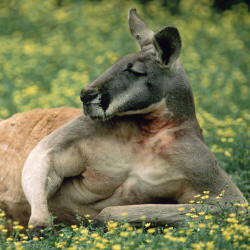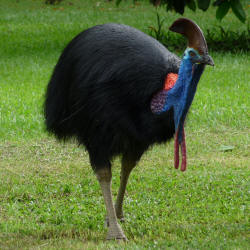World Animals
Australian Animals
Kangaroo

Animal Kingdom: Long legged rabbit, Mammal
Population: app. 34.303.677
Size: H: app. 1.5 m, L: app. 2.3 m
Weight: 18 kg - 95 kg
Life Expectancy: 4 years - 10 years
Food source: Healthy vegetables
Max. speed: 55 km/h
Nutritional value: Like beef just with a twist of lime
The incredibly buff animal likes to lay down on the grass and lick some sun when no
predators are nearby. It enjoys life so hardly, that it doesn't care
about human presence at all. Some Kangaroos weigthlifts a lot like the one on
the pictures and ends up with a totally ripped body like the heroes in
the action movies. They sleep like a pig when they can, otherwise they
are the most alert animals in Australia. Don't mess around with these
guys, or else you could end up facing Kangaroo Arnold in a face to face
fight, which you will certainly not survive.
The kangaroo is a marsupial from the family Macropodidae (macropods,
meaning 'large foot'). In common use the term is used to describe the
largest species from this family, especially those of the genus
Macropus, red kangaroo, antilopine kangaroo, eastern grey kangaroo and
western grey kangaroo. Kangaroos are endemic to Australia. The smaller
macropods are found in Australia and New Guinea.
Larger kangaroos have adapted much better[which?] to changes brought to
the Australian landscape by humans and though many of their smaller
cousins are endangered, they are plentiful. They are not farmed to any
extent, but wild kangaroos are shot for meat, leather hides, and to
protect grazing land for sheep and cattle. Although there is some
controversy, harvesting kangaroo meat has many environmental and health
benefits over traditional meats.
Kangaroos have large, powerful hind legs, large feet adapted for
leaping, a long muscular tail for balance, and a small head. Like most
marsupials, female kangaroos have a pouch called a marsupium in which
joeys complete postnatal development.
Cassowary

Animal Kingdom: Assassin Bird, Avec/Dinosaur
Population: app. 2.000
Size: H: app. 1.75 m, W: app. 1.75 m
(Wingspan)
Weight: 25 kg - 58.5 kg
Life Expectancy: 40 years - 60 years
Food source: Slays other animals for fun, eats
vegetables
Max. speed: 50 km/h
Nutritional value: A lot of weird vitamins and minerals
The cassowaries are ratites (flightless birds without a keel on their
sternum bone) in the genus Casuarius native to the tropical forests of
New Guinea, nearby islands, and northeastern Australia.[2] There are
three extant species recognized today. The most common of these, the
Southern Cassowary, is the third tallest and second heaviest living
bird, smaller only than the ostrich and emu.
Cassowaries feed mainly on fruit, although all species are truly
omnivorous and will take a range of other plant food including shoots,
grass seeds, and fungi in addition to invertebrates and small
vertebrates. Cassowaries are very shy, but when provoked they are
capable of inflicting injuries to dogs and people, although fatalities
are extremely rare.
Cassowaries have a reputation for being dangerous to people and domestic
animals. During World War II American and Australian troops stationed in
New Guinea were warned to steer clear of them. In his book Living Birds
of the World from 1958, ornithologist Ernest Thomas Gilliard wrote:
"The inner or second of the three toes is fitted with a long, straight,
murderous nail which can sever an arm or eviscerate an abdomen with
ease. There are many records of natives being killed by this bird."
This assessment of the danger posed by cassowaries has been repeated in
print by authors including Gregory S. Paul (1988)[20] and Jared Diamond
(1997).[21] Of 221 attacks studied in 2003, 150 were against humans. 75%
of these were from cassowaries that had been fed by people. 71% of the
time the bird chased or charged the victim. 15% of the time they kicked.
Of the attacks, 73% involved the birds expecting or snatching food, 5%
involved defending natural food sources, 15% involved defending
themselves from attack, 7% involved defending their chicks or eggs. The
150 attacks included only one human death:[22]
The one documented human death was caused by a cassowary on 6 April
1926. 16-year-old Phillip McClean and his brother, aged 13, came across
a cassowary on their property and decided to try to kill it by striking
it with clubs. The bird kicked the younger boy, who fell and ran away as
his older brother struck the bird. The cassowary then charged and
knocked the older McClean to the ground and kicked him in the neck,
opening a 1.25 cm (0.49 in) wound which may have severed his carotid
artery. The boy managed to escape, but died shortly afterwards as a
result of his injuries.[23]
Cassowary strikes to the abdomen are among the rarest of all, but there
is one case of a dog that was kicked in the belly in 1995. The blow left
no puncture, but there was severe bruising. The dog later died from an
apparent intestinal rupture.